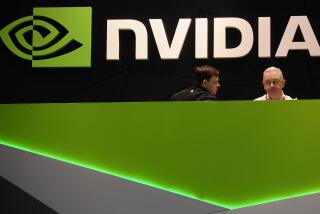The Cutting Edge: Computing / Technology / Innovation : Firm Claims Cheaper, Better MRI Scan
Magnetic resonance imaging has become an important medical diagnostic tool, but unfortunately for patients, it involves an average of 40 minutes in a claustrophobia-inducing metal tube. And the best images are obtained in the more expensive equipment.
Superconductor Technologies, based in Santa Barbara, believes it has a way to cut down on the time spent in an MRI machine, improve image quality and reduce costs. The company says its SuperSensor Coil, based on high-temperature superconductor technology, will either produce equal-quality images in a quarter of the time or turn out images in the same time that are 50% to 150% better. This, in turn, will enable less expensive MRI machines to produce images of the same quality as those from the more expensive machines.
The SuperSensor is a surface coil that acts as an antenna when placed next to the body area being imaged. It can take the place of the copper coils currently used in MRI machines without any modification.
*
Smart dipsticks: In the 1980s, chemist Robert Kauffman and physicist Douglas Wolf at the University of Dayton developed a way to gauge more accurately the remaining useful life of engine oils in military aircraft. The Air Force used their “smart dipstick” during Operation Desert Storm.
Now the university has entered into two joint ventures to make a family of instruments for assessing engine--and cooking--oil. The “smart dipstick” uses a computerized electrochemical sensor that measures the oil’s level of antioxidant, an additive that slows an oil’s degradation. The antioxidant level tells when an oil has lost its lubricating or cooking properties.
Fluitec, a Dayton-based company, will market the technology primarily to the lubricating oil and fuel industries. Herguth Laboratories, an analytical laboratory in Vallejo, Calif., has purchased Fluitec’s hand-held RULER (Remaining Useful Life Evaluation Routine) to help the nuclear power industry know when to change the oil in reactor coolant pumps. Alas for motorists, the devices will cost $1,500 to $3,500 each. Gem City Engineering, another Dayton company, will test a smart dipstick at Rally’s, a fast-food chain.
*
Transistor crush: As semiconductor makers cram more transistors onto smaller silicon chips, the problem of how to prevent the transistors from interfering with each other grows. The transistor, after all, is a switch that is either on or off. When on, it carries a current that may leak to other transistors, turning them on when they shouldn’t be. When there were fewer transistors on a chip, transistors could be insulated from one another by tiny walls. But the more transistors, the less room for all that insulation.
Two technologies have emerged to deal with this problem. The most common is called “silicon on insulator.” SOI puts the insulator under the transistor, because researchers believe the leaking current travels downward into the silicon before jumping to another transistor.
Mitsubishi, a Japanese semiconductor maker, is using this technique in its most advanced memory under development, the 256-megabyte dynamic random access memory chip. Motorola and IBM are also developing chips using SOI.
An alternative is being pursued at AT&T;’s Bell Labs. Rather than injecting insulation below the surface of the entire silicon wafer, as is done in SOI, two tiny areas of insulation are created under each transistor. Bell researchers say this achieves the same effect with less damage to the wafer.
*
Tracking rapists: Technology developed for cellular telephone networks and satellite tracking of mobile missiles may help police better predict where a serial rapist will strike next. University of Virginia researchers have developed software that tries to predict not only where the rapist will show up next, but even where he lives. Experience shows that serial rapists tend to be either “locals” who strike mostly around their homes, or “marauders” who travel in search of victims. Using data from 700 rape cases of a serial nature, the researchers have tried to “reverse-engineer” the reasoning of the rapists in choosing locations. A few patterns have already emerged: Rapists tend to travel north and south of their homes, for example.
*
Oops! Folks at Comsat Video Enterprises chuckled after they read last week about their video-on-demand system for hotel rooms. They rightly noted that having hotel workers slamming tapes into VCRs would be something like the Flintstones’ keeping a creature under the sink to serve as a garbage disposal. In fact, Comsat’s computer-controlled video recorders--a minimum of 30, sometimes more than 100 of them--are pre-loaded. When a movie is ordered, a computer switches that machine on and sends the movie to the guest’s TV.
More to Read
Inside the business of entertainment
The Wide Shot brings you news, analysis and insights on everything from streaming wars to production — and what it all means for the future.
You may occasionally receive promotional content from the Los Angeles Times.










